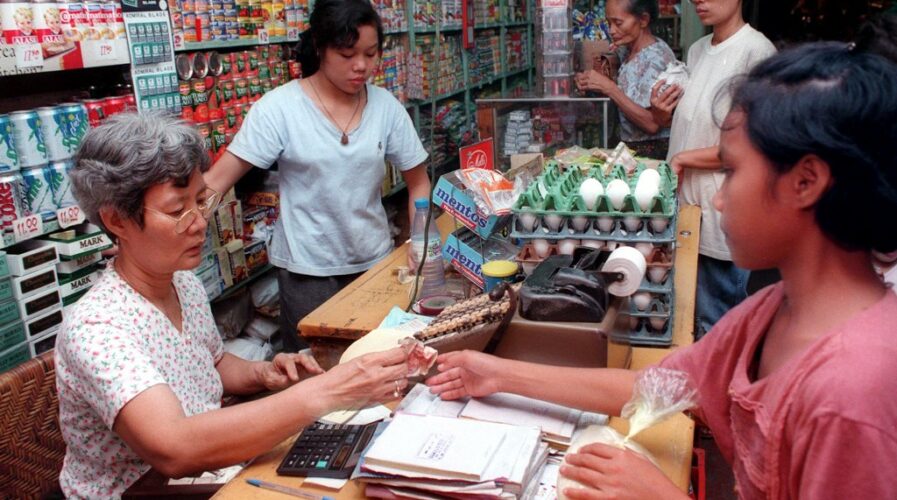
COVID-19 has made Filipinos wary of cash transactions, and digital payments is finally having its day in the archipelago. Source: AFP
The Philippines is going cashless – finally
In the Philippines, cash is king, and has been for a long time. While bank transfer is the most popular digital payments method across the Southeast Asian region, in the Philippines, 80% of online sellers use cash on delivery as the preferred payment method.
Five years ago, with nearly 41% of the population on the internet, a staggering 1% of retail payments were made electronically. But the landscape has really shifted in 2020, as the COVID-19 pandemic is causing Filipino consumers to abandon cash.
That’s partly out of fear of contracting the coronavirus via physical contact, but as is the case everywhere else, the pandemic has pushed e-commerce in the region like never before. With the Philippines joining force, digital payments in Southeast Asia could surpass US$1 trillion by 2025, accounting for nearly one out of every two dollars spent– a monumental acceleration.
The Philippines has been slow to adapt to digital payments compared to similarly-sized neighbours. Up until recently, about 98% of Filipinos didn’t possess credit cards.
But Kacper Marcinkowski, CEO of e-payment company TendoPay, has for a long time predicted the island nation could “skip the phase of credit cards” altogether.
“Everyone is always saying that [the] Philippines is perfect for it because it has a tech-savvy population,” Marcinkowski told Tech in Asia back in 2018. “E-commerce can be the factor that drives the adoption of digital payments.”
Marcinkowski was right that e-commerce would spur the wider take-up of non-cash payments, and the emerging weapon of choice seems to be e-wallets.
GCash is the biggest e-payment platform in the Philippines. It has over 20 million registered users and can be used at approximately 63,000 physical and online stores, and since mid-March, when the pandemic was in full swing, it’s witnessed a massive surge in new users.
In May, the number of transactions flowing through GCash was eight times higher than at the same period in 2019. The demand was so strong that GCash had to upsize its e-wallet limits last month to enable its user base to continue making e-commerce transactions.
Meanwhile, the market-leading e-commerce platform in the region, Shopee reported a surge in digital payments on its platform, with many older consumers purchasing from the platform for the first time ever, with an increase in payments made for things like mobile phone reloads, bill payments, and for household items – trends that weren’t so noticeable prior to COVID-19.
GCash’s main e-wallet competitor PayMaya, on the other hand, has gone with a slightly different marketing approach to increase its footprint in the Filipino digital payments space, by partnering with various entities to fuel their electronic payment possibilities. The digital payments provider is collaborating with the city of Manila to deploy contactless payments via its PayMaya QR method to the city’s newly-launched cashless stalls around the Manila City Hall and in Divisoria, the city’s popular bargain shopping market.
In addition, the top quick-service restaurants (QSRs) in the country like Jollibee, McDonald’s, and KFC have all adopted PayMaya’s end-to-end digital payments solutions for enterprise – comprising the ‘One by PayMaya Point of Sale’ (POS) devices for in-store and drive-thru, PayMaya’s digital payment gateway, as well as digital invoicing solutions to process online orders.
“Cashless is now emerging as the preferred mode of payment for consumers under the New Normal,” says PayMaya president Shailesh Baidwan. “With QSRs adopting PayMaya’s end-to-end digital payments solutions, customers and frontliners are experiencing a better way to pay that’s safer and more convenient.”
PayMaya is the only end-to-end digital payments ecosystem enabler in the Philippines, with platforms and services that cut across consumers, merchants, and even the government. PayMaya supports various social agendas too such as financial inclusion, providing possibly the fastest method to start a digital finance account, and its ‘Smart Padala by PayMaya’ network of over 30,000 partner touchpoints offers financing access for the unbanked and underserved communities of the country.
PayMaya account holders will even be able to participate in the government’s upcoming Retail Treasury Bonds offering, allowing those who do have a bank account yet to participate in government-backed bonds investment opportunities, that are due to mature in 2025.
PayMaya’ systems are powering payments in everything from agriculture to commute rides, while GCash has agreed to work with the government to equip taxis to enable them to accept QR-based payments as well.
Complementing the flourishing digital payments landscape even further is Marcinkowski’s TendoPay, offering consumers a digital installment plan solution that will allow them to shop at the over 2,900 7-Eleven stores in the Philippines, and pay later for their purchases in installments ranging from 15 days up to 24 months.
“It allows them to make purchases whenever they actually need them. Then they can repay them once they get their salary or even spread the cost over several months. It’s a very convenient way of managing your finances especially at a time of pandemic,” CEO Marcinkowski commented. TendoPay also has an Employee Benefits program where employees are offered their TendoPay via their employer, allowing low-income workers to gain access to a relatively large credit limit and low-interest rates.
Marcinkowski wants to financially empower marginalized communities in the Philippines, where nearly 17% of the population live below the poverty line. “We think that in a complex sector like fintech it’s important to specialize or focus on one problem only. In our case, it’s providing Filipinos affordable and convenient financing.”
READ MORE
- Strategies for Democratizing GenAI
- The criticality of endpoint management in cybersecurity and operations
- Ethical AI: The renewed importance of safeguarding data and customer privacy in Generative AI applications
- How Japan balances AI-driven opportunities with cybersecurity needs
- Deploying SASE: Benchmarking your approach


